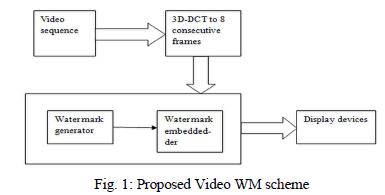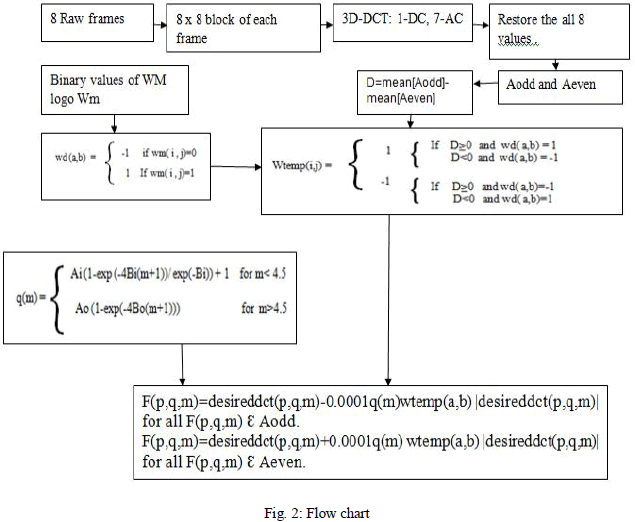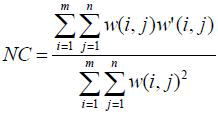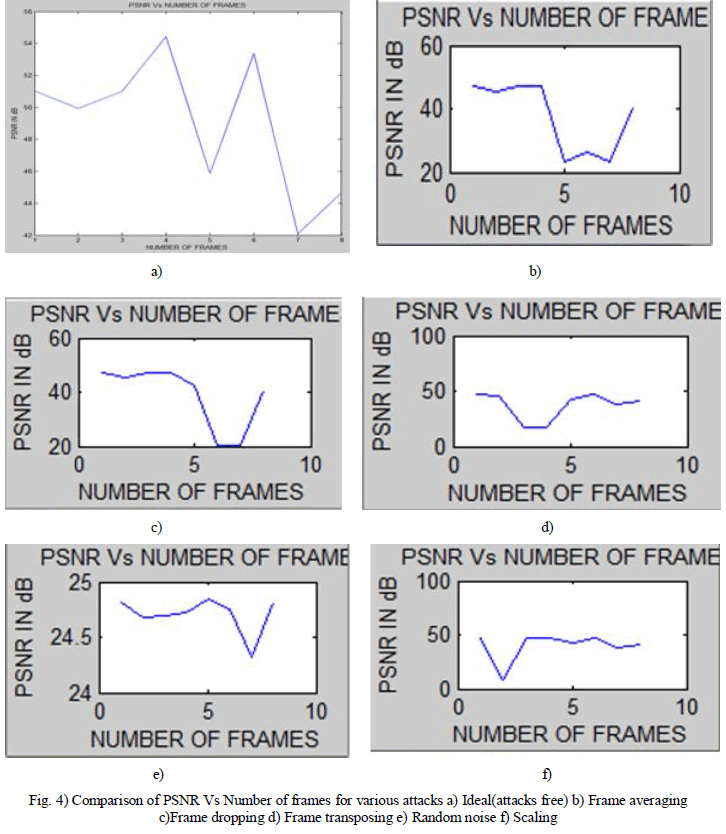ISSN ONLINE(2278-8875) PRINT (2320-3765)
ISSN ONLINE(2278-8875) PRINT (2320-3765)
Krishnamoorthi1, Anitha Devi M.D2, Dr.M.Z.Kurian3, K.Vishwanath Reddy4
|
| Related article at Pubmed, Scholar Google |
Visit for more related articles at International Journal of Advanced Research in Electrical, Electronics and Instrumentation Engineering
This paper presents implementation of Digital Water marking for video sequences using 3D-DCT Approach. In this method Water Mark (WM) is embedded in the DCT domain of uncompressed video sequences by modifying the 3D-DCT Coefficients in each 8 x 8 blocks of individual frames. Mid-range frequency coefficients are selected to insert the WM. In this, WM is spread in both frequency and spatial domain of video stream since each block contains both temporal and spatial information of video. Secret key is generated from binary WM image and same is used during the extraction of WM. This 3D-DCT has the advantage of reducing inter frame redundancy among number of consecutive frames with less computation time and encoder complexity
Keywords |
| Digital Watermarking, 3D-DCT |
INTRODUCTION |
| Watermarking is a branch of information hiding which is used to hide the proprietary information in digital media, provides excellent insight into watermarking. Rising interest in digital watermarking due to the increase in the need for copyright protection. Application of video watermarking are-copy control, broadcast monitoring, video authentication and copyright protection. There is a copyright infringement due to the exchange of digital content over peer-to-peer network. Hence these digital contents must be watermarked. Digital watermarking is the process of embedding an additional, identifying information within a host multimedia object, such as text, audio, image, or video. By adding a transparent watermark to the multimedia content, it is possible to detect critical alterations, as well as to verify the integrity and the ownership of the digital media; digital video WM techniques are widely used in various video applications. For video authentication, WM can ensure that the original content has not been altered. WM is used in fingerprinting to track back a malicious user and also in a copy control system with WM capability to prevent unauthorized copying. Due to commercial potential applications, present digital WM techniques have focused on multimedia content and in particular on video data. In this paper, digital watermarking for Video based on 3D-DCT coefficients modification is presented. 3D-DCT provides better energy economy, less memory consumption reduced redundancy with less computation time. Section 2 describes the related work. Section 3 describes the detail of the proposed method. Section 4 describes the performance measurement. Section 5 presents the experimental setting and results. |
RELATED WORKS |
| Sonjoy Deb Roy et al. [1] proposed Hardware Implementation of a Digital Watermarking System for Video Authentication that can insert semi fragile, invisible Water Mark information into compressed video streams using DCT. FPGA with Pipeline and parallelism architecture is carried out. Mauro Barni et al. [2], suggested new algorithm where PN sequence of real number is embedded in a selected DCT co-efficient of digital image. Author concluded as this system is robust to other technique with experimental result. Yui-lam-chan et al. [3] , Dr. B. S.Nagabhushana [4] dealt with Three-dimensional discrete cosine transform (3-D DCT) and described the merits of 3D-DCT like reducing the inter frame redundancy among a number of consecutive frames and hence better compare to 2-DCT with JPEG. Jin Li1, et al. [5], modelled 3D-DCT as zero-quantized DCT for video encoding and it has powerful energy concentration. Raymond West Water et al. [6] proposed XYZ video compression of 3D-Discrete Cosine Transform it takes the merits of statistical behavior of video data both in spatial and temporal domain. Author showed with result that the optimum quantizer algorithm is superior compare to MPEG standard with experimental result. Mark Servais,et al. [7], introduced software based technique which involves computation of 3D-DCT of successive groups of 8 frames. Vivek Kumar Agrawal [8], dealt with variable length Cosine Transform. Where author proposed that water mark is spread both in spatial and temporal domain. Hence it is robustness is achieved against frame averaging, frame dropping, noise addition and lossy compression. Mehdi, Khalili, [9], proposed a approach where host image is converted into YCbCr channels; then embedding the watermark in the approximation coefficients of DWT of the host image. The experimental results show that the proposed method provides extra imperceptibility and robustness of watermarking against wavelet compression attacks compared to the traditional methods in RGB colour space. Prathik et al. [10], Introduced the frame adaptive algorithm, with the use of swarm optimization for selection of frames. BER is used to compare and find out the strength of water mark. Obtained PSNR values shows that proposed algorithm will serve as good WM agent. SD-BPSO is a novel algorithm serves as effective optimizer by selecting suitable frames for better imperceptibility. Hui-Yu Huang et al. [11] proposed Pseudo 3D-DCT, where inserting a WM into the uncompressed DCT domain by adjusting the correlation between the desired DCT blocks. |
| From the Literature survey it was observed that, existing system 2D-DCT has redundancy in Motion compensator. It has more transmission time, memory consumption and more computation time with complex encoder circuit. . Hence 3D-DCT provides better energy economy, less memory consumption, reduced redundancy with less computation time. Reduced encoder complexity compare to 2D-DCT with MPEG. |
PROPOSED METHOD |
 |
| In the proposed approach shown in figure 1, Watermark is embedded in the desired DCT coefficient of video sequence (240x320). Water mark generation and embedding is performed in MAT Lab. |
| Pseudo 3D-DCT: Considering the 8 consecutive frames as a group. Each frame is divided into 1200 blocks of 8x8 each. 2D-DCT is applied is applied to all blocks of each frame. 1D-DCT is applied to DC Values present in the same location of each frame corresponds to all 1200 blocks, which gives 1-DC and 7-AC values. This is known as Pseudo 3D-DCT [11]. |
| Water Mark Generation: Considering binary logo image (wd: 19x40) as Water Mark. Encoding the desired 760 bits of WM image as follows. |
 |
| Water Mark Embedding: Initially among 8 3D-DCT Coefficients, considering 6 mid-frequency coefficients. These 6 coefficients is divided into 2 sets of Aodd and Aeven [12]. D is the difference between sample mean of Aodd and Aeven corresponds to each block. D= mean ( Aodd) – mean (Aeven) |
| Modifying the 6 3D-DCT coefficients of 8 frames as follows. F(p,q,m)=desireddct(p,q,m)-0.0001q(m) wtemp(a,b) |desireddct(p,q,m)| for all F(p,q,m) Ãâ ÃÂ Aodd. F(p,q,m)=desireddct(p,q,m)+0.0001q(m) wtemp(a,b) |desireddct(p,q,m)| for all F(p,q,m) Ãâ ÃÂ Aeven. |
| Where |
 |
| The term desireddct is the original 3D-DCT coefficients; F is the modified 3D-DCT coefficients |
 |
| Where Ai, Ao, Bi, Bo are constants Ai=Ao=255, Bi=0.0001, Bo=10. |
| It can be noted that , DC coefficient of first and AC coefficient of 8th frame are remain unchanged after WM embedding due to mid frequency coefficients is chosen for WM embedding. After this WM embedding process, Inverse 3D-DCT is applied to the modified coefficients of each block. Figure 2 shows the flow chart corresponds to proposed approach. |
 |
| Transparency and robustness can be measured by PSNR (Peak Signal to Noise Ratio) and NC (Normalized Correlation) respectively. |
| PSNR is calculated from original and WM frames as follows. |
| PSNR = 10 log10 (R / MSE) |
| Where P=240, Q=340 and R=1 is considered in this context. Iw(p,q) and Io(p,q) are the watermarked and original frame respectively. |
| Robustness of watermarking is measured by Normalized Correlation (NC). Similarity between original and extracted water mark can be computed as follows. |
 |
| W (i, j) and W’ (i, j) are the original and extracted watermarks. m and n are the size of water mark i.e., m=19 and n=40 in this context. |
EXPERIMENTAL RESULTS |
| In this proposed approach, 240x320 raw video sequences with 114 frames with 8 frames as a group are considered. The water mark logo with a size or 19x40 is encoded into pseudo random sequences. Figure 3 shows the water mark logo, original frame and water marked frame. |
 |
Robustness against the attacks: |
| 1. Frame averaging: In this attack, average of 2, 3 or 4 frames are computed and those frames are replaced with the resultant average frames. Here 5,6 and 7th frame is averaged |
| 2. Frame dropping: In this attack, one or more frames are dropped from the watermarked video sequences. Here is 6th frame is dropped from the watermarked sequences |
| 3. Frame transposing: Order of the consecutive frames is modified by this attack. In this experiment, 4th and 3rd frames are exchanged. |
| 4. Random Noise: Pseudo Random noise is distributed all over the 8 frames by this attack. |
| 5. Scaling: Geometric translation in spatial and temporal domain is scaling. |
 |
 |
| From above graphs and table one can observe that, proposed approach using 3D-DCT is achieved better PSNR and NC values i.e. PSNR of approximately greater than or equal to 20dB and NC of about 40% with and without attacks when compare to the conventional 2D-DCT approach. |
CONCLUSION |
| To overcome some of the disadvantages of 2D-DCT methods, the new technique is introduced that is the digital watermarking method based on 3D-DCT coefficients modification for Video. This 3D-DCT has the advantage of reducing interframe redundancy among number of consecutive frames with less computation time and encoder complexity. But degradation for complex scenes with greater amount of motion in 3D-DCT Coding. Better PSNR Value is obtained about of 42 to 55 dB for 8 consecutive frames compare to 2D-DCT Approach. Future enhancement can be done by implementing the proposed algorithm in the hardware. Robustness can be increased by embedding entire WM logo into the video frames; meanwhile complexity can be added in secret key generation to increase the security level. |
References |
|